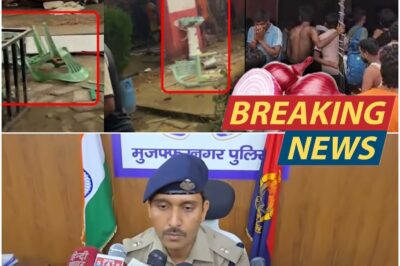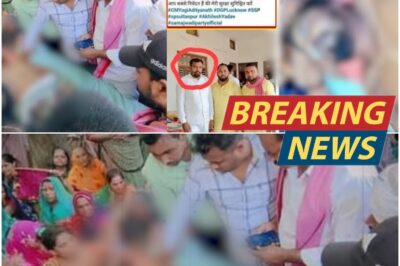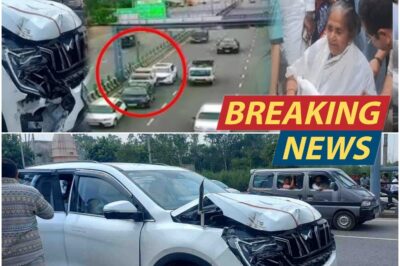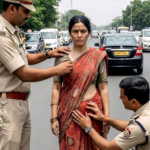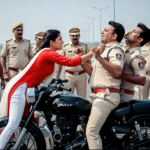Pilot Refuses to Fly Deputy CM Eknath Shinde’s Private Plane: What Led to the Standoff?
Pilot Refuses to Fly Deputy CM Eknath Shinde’s Private Plane: A High-Drama Incident at Jalgaon Airport
In a dramatic turn of events at Maharashtra’s Jalgaon Airport, Deputy Chief Minister Eknath Shinde found himself in an unexpected standoff with the pilot of his private chartered plane. The pilot refused to fly the aircraft, citing exhaustion and duty hour limitations, leading to a tense situation that lasted for nearly an hour. What unfolded was a mix of high-stakes drama, intense negotiations, and a deeper look into aviation safety regulations.
This is the story of how a seemingly routine political visit turned into a spectacle, highlighting the challenges of balancing VIP schedules with aviation safety norms.
.
.
.
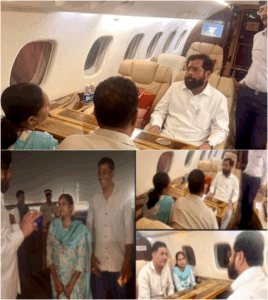
The Prelude: A Spiritual Visit Turns Sour
Deputy CM Eknath Shinde, along with ministers Girish Mahajan and Gulabrao Patil, was on a visit to Muktainagar in Jalgaon district to participate in the Sant Muktabai Palakhi Yatra, a significant spiritual procession. The visit was part of his ongoing efforts to connect with the people and honor Maharashtra’s rich cultural and spiritual heritage.
After successfully attending the event, Shinde and his team were set to return to Mumbai via a private chartered plane. However, what awaited them at the Jalgaon Airport was anything but smooth.
The Unexpected Standoff: Pilot Refuses to Fly
As the team arrived at the airport and prepared to board the plane, the pilot of the chartered aircraft dropped a bombshell: he refused to take off. The reason? His duty hours had exceeded the permissible limit, and he was physically unfit to fly further.
The announcement sent shockwaves through the airport. The Deputy CM, his ministers, and the accompanying administrative staff were left scrambling for a solution. The pilot stood firm, explaining that he had already been flying for 12 consecutive hours and was now legally and physically unable to operate the aircraft.
According to aviation regulations, pilots are subject to strict duty hour limits to ensure safety. The Directorate General of Civil Aviation (DGCA) mandates that pilots cannot fly beyond 8 to 9 hours in a single day, depending on various factors like the time of day, the number of flights, and the length of the journey. After completing their duty hours, pilots are required to rest for a minimum of 12 to 14 hours before taking another flight.
The pilot’s refusal to fly was in line with these regulations, but it created a highly awkward situation for the VIP passengers. The Deputy CM and his team were now stranded at the airport, with no immediate solution in sight.
Negotiations Begin: Ministers Step In
As the tension mounted, Ministers Girish Mahajan and Gulabrao Patil took it upon themselves to resolve the issue. They approached the airline company, attempting to explain the urgency of the situation. The ministers argued that the Deputy CM’s schedule was packed with important commitments, and delaying the flight would disrupt his plans.
Despite their efforts, the pilot remained adamant. He reiterated that his duty hours were over and that flying in his current state would compromise the safety of everyone on board. The pilot also cited health reasons, explaining that he was physically exhausted after a long day of flying.
The ministers, along with the airport officials, continued to negotiate with the airline company. After nearly an hour of back-and-forth discussions, the airline management intervened and convinced the pilot to reconsider. They assured him that the flight would be short and that all safety protocols would be followed.
Eknath Shinde Steps In: The Turning Point
As the situation dragged on, Deputy CM Eknath Shinde himself decided to step in. Known for his calm demeanor and problem-solving approach, Shinde personally approached the pilot to understand his concerns. In a one-on-one discussion, he assured the pilot that his well-being was a priority and that the flight would not pose undue strain on him.
Shinde’s personal intervention seemed to make a difference. After a 45-minute standoff, the pilot finally agreed to fly the plane. The tense atmosphere at the airport eased as the Deputy CM and his team boarded the aircraft. The flight took off without any further issues, but the incident left everyone reflecting on the importance of balancing VIP demands with aviation safety.
Understanding the Aviation Rules: Why the Pilot Refused
The incident at Jalgaon Airport highlights the strict regulations governing pilots’ duty hours and rest periods. These rules are designed to ensure the safety of passengers and crew by preventing fatigue-related errors.
According to DGCA guidelines:
-
Duty Hours Limit: Pilots can only fly for 8 to 9 hours in a day, depending on factors like the number of flights, the time of day, and the length of each flight.
Rest Periods: After completing their duty hours, pilots must rest for at least 12 to 14 hours before flying again. The exact rest period depends on the duration and nature of their previous duty.
Night Flights and Long Journeys: Pilots operating night flights or long-haul journeys require longer rest periods to recover.
Alternate Arrangements: If a pilot is unable to fly due to duty hour limitations, the airline is responsible for arranging a replacement pilot or delaying the flight until the pilot has rested sufficiently.
These rules are non-negotiable, even for VIP passengers. In this case, the pilot’s refusal to fly was not only justified but also in compliance with these safety norms.
Public Reaction: Mixed Opinions
The incident quickly became a topic of discussion, with mixed reactions from the public. While some criticized the pilot for refusing to accommodate the Deputy CM, others praised him for prioritizing safety over VIP demands.
Aviation experts and industry insiders supported the pilot’s decision, emphasizing the importance of adhering to safety regulations. “Fatigue is a major factor in aviation accidents. Pilots are trained to recognize their physical and mental limits, and refusing to fly when unfit is a mark of professionalism,” said a senior pilot.
On the other hand, some questioned the planning and coordination of the Deputy CM’s travel arrangements. “VIP schedules are often tight, but it’s the responsibility of the organizers to ensure compliance with aviation rules. This incident could have been avoided with better planning,” commented a political analyst.
Lessons Learned: The Need for Better Planning
The Jalgaon Airport incident serves as a reminder of the challenges involved in organizing VIP travel. It underscores the need for better coordination between government officials, airlines, and aviation authorities to avoid such situations in the future.
Key takeaways include:
-
Advance Planning: VIP schedules should account for aviation regulations, ensuring that pilots have sufficient rest and duty hours to accommodate the flight.
Backup Arrangements: Airlines should have backup pilots or relief crew members available for VIP flights to handle unforeseen delays or duty hour limitations.
Awareness of Rules: Government officials and VIPs should be made aware of aviation safety norms to avoid unrealistic expectations
Play video:
Conclusion: A Balancing Act
The standoff at Jalgaon Airport may have ended with a resolution, but it raises important questions about the balance between VIP protocols and aviation safety. While the Deputy CM and his team eventually reached their destination, the incident highlighted the professionalism of the pilot and the importance of adhering to safety regulations.
As Maharashtra continues to navigate the complexities of governance and development, incidents like this serve as a reminder that even the most powerful individuals must respect the rules designed to protect everyone. After all, in the skies, safety always comes first.
News
Missing PG Student Monica from Darbhanga CM College Found in Shocking Condition—Police Stunned
Missing Darbhanga CM College Student Monica Found Safe—Reveals She Left Home Willingly to Marry A week-long mystery surrounding the disappearance…
Chaos on the Kanwar Yatra: Devotees Go on Rampage, Vandalize Dhaba from Muzaffarnagar to Roorkee!
Kanwar Yatra Turns Violent: Kanwariyas Vandalize Dhabas from Muzaffarnagar to Roorkee Over Onion in Food A shocking wave of violence…
Uproar After Samajwadi Party Leader Sunil Yadav’s Death: Ex-MLA and Brother-in-Law Named in FIR!
Uproar in Sultanpur After Samajwadi Party Leader Sunil Yadav’s Mysterious Death: Former MLA and Brother-in-Law Named in FIR A wave…
Shocking Viral Video: Teacher Beats Student with Stick in Bihar School—Discipline or Violence?
Bihar School Turns Battleground: Viral Video Shows Teacher Beaten Brutally by Angry Parents—Discipline or Violence? A shocking video has taken…
Forced to Strip at Knifepoint: Obscenity in the Name of Jobs—What’s Happening in Uttar Pradesh?
Job Promise Turns Nightmare: Woman Forced to Undress at Knifepoint in Uttar Pradesh Official’s Quarters Uttar Pradesh: A shocking video…
UP Education Minister Injured in Road Accident as Convoy Cars Collide
UP Education Minister Gulab Devi Injured in Road Accident as Convoy Cars Collide Hapur, Uttar Pradesh: Uttar Pradesh’s Education Minister,…
End of content
No more pages to load


